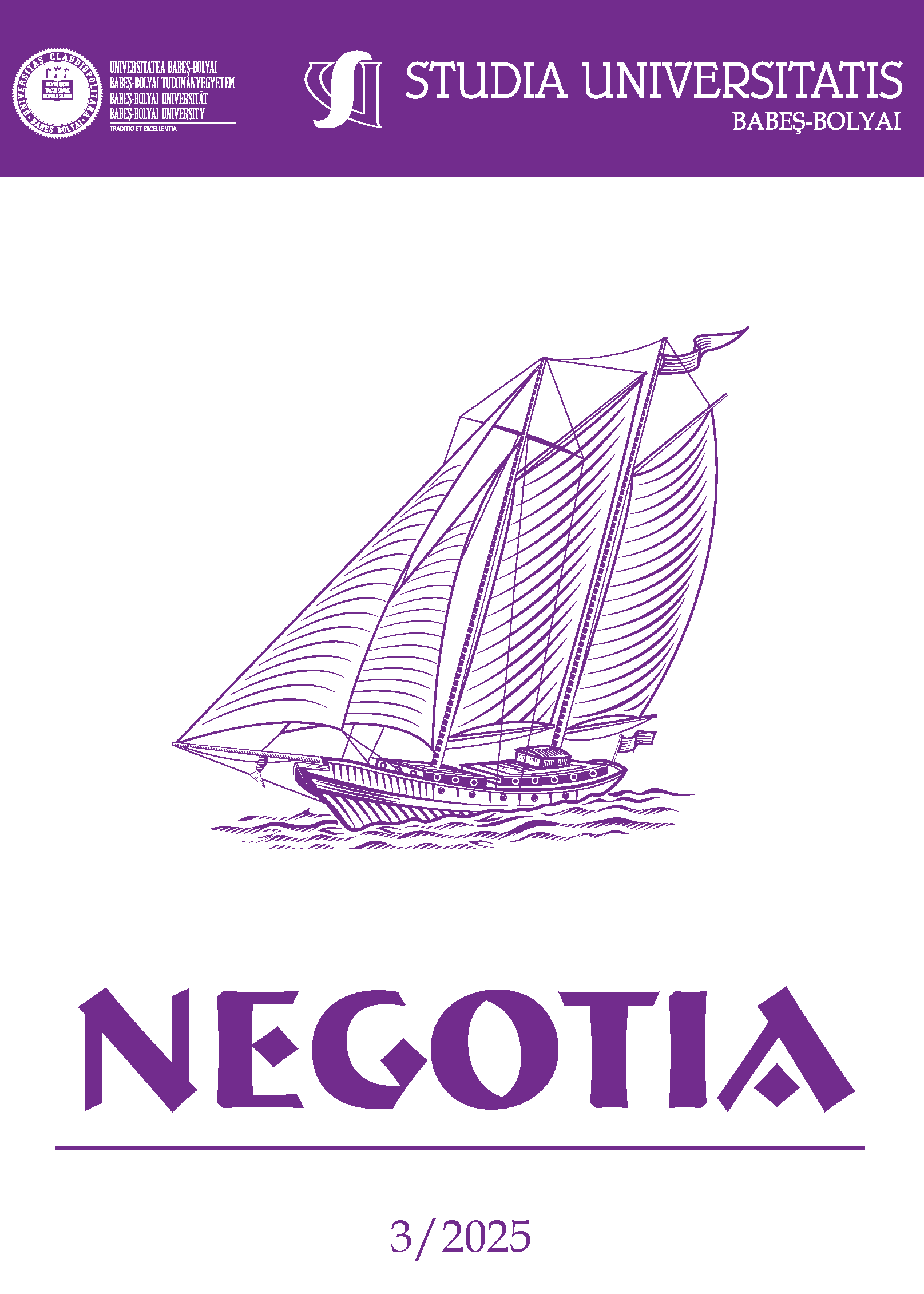THE PILGRIM’S PATH: WHO WALKS WHERE AND WHY ON THE CAMINO DE SANTIAGO
DOI:
https://doi.org/10.24193/subbnegotia.2025.3.01Keywords:
pilgrimage, Camino de Santiago, motivations, routes difficultyAbstract
The examination of why people make journeys to sites of religious significance constitutes a fundamental research question within tourism studies. This inquiry represents a central theoretical concern that intersects multiple disciplinary perspectives, including anthropology, psychology, sociology, and religious studies, necessitating comprehensive analytical frameworks to understand the complex motivational structures underlying contemporary religious travel behavior. The contemporary phenomenon of pilgrimage has undergone a paradigmatic shift from traditional religious frameworks, demonstrating the influence of diverse sociocultural and individual variables. This transformation in pilgrimage conceptualization emerges from several contributing factors: evolving personal value systems and belief structures, technological innovations that improve information accessibility and interpersonal communication, and a growing interest in individualized searches for existential meaning and spiritual connectivity within an increasingly secular societal context. Whereas medieval pilgrimage practices were primarily anchored in religious conviction and penitential purposes, contemporary pilgrimage experiences exhibit significantly greater motivational diversity, reflecting the multifaceted nature of modern human complexity. The main objective of the present exploratory study is to examine factors that influence pilgrims’ choice of route difficulty on Camino de Santiago, using 272 valid responses from 331 collected surveys. Given the limited sample size, the research adopts an exploratory approach to identify preliminary relationships and patterns for future large-scale studies. The analysis employs PLS-SEM and multigroup analysis using SmartPLS 4 software. Given the methodological constraints, the findings should be considered indicative rather than definitive. This research offers both academic and practical value, providing theoretical contributions to pilgrimage studies while providing actionable insights for diverse stakeholders involved in Camino de Santiago route management and pilgrim experience optimization.
JEL classification: L80, L83, Z00, Z39
Article History: Received: August 20, 2025; Reviewed: September 8, 2025;
Accepted: September 22, 2025; Available online: September 29, 2025
References
Amaro, S., Antunes, A. & Henriques, C. (2018). A closer look at Santiago de Compostela’s pilgrims through the lens of motivations, Tourism Management, 64, 271-280, http://doi.org/10.1016/j.tourman.2017.09.007
Bădulescu, A. & Ban, O. (2005). Turismul Religios. Amfiteatru Economic, Nr.18, 69-78.
Bode (Tuns), O.R. (2018). Turismul - motor economic la nivel mondial. Cluj-Napoca: Presa Universitară Clujeană.
Brumec, S., Lavrič, M. & Naterer, A. (2023). Examining Motivations to Walk the Camino de Santiago: A Typology of Pilgrims. Pastoral Psychology, 72(4), 479-500. https://doi.org/10.1007/s11089-023-01071-1
Cocean, R., Moisescu, O. I. & Toader, V. (2014). Economie şi planificare strategică în turism. Cluj-Napoca: Risoprint.
Dallen, J. & Olsen, H. (2006). Tourism, Religion and Spiritual Journeys. New York: Routledge.
Davidson, K. L. & Gitlitz, D. (2002). Pilgrimage: From the Ganges to Graceland. Santa Barbara: ABC-Clio.
Davidson, K. L. & Dunn, M. (2012). The Pilgrimage to Compostela in the Middle Ages. Taylor and Francis.
Future Market Inisghts. Retrieved 01 15, 2024, from Future Market Inisghts: https://www.futuremarketinsights.com/reports/faith-based-tourism-sector-overview
Kim, H., Yilmaz, S. & Ahn, S. (2019), Motivational Landscape and Evolving Identity of a Route-Based Religious Tourism Space: A Case of Camino de Santiago, Sustainability, 11(13), 3547. https://doi.org/10.3390/su11133547
Klimiuk, J. & Moriarty, K. J. (2021). The Lourdes Pilgrimage and the Impact on Pilgrim Quality of Life. Journal of Religion and Health, 60, 3775–3787. https://doi.org/10.1007/s10943-021-01398-0
Kock, N. (2015). Common Method Bias in PLS-SEM: A Full Collinearity Assessment Approach. International Journal of e-Collaboration (IJeC), 11(4), 1-10. https://doi.org/10.4018/ijec.2015100101
Lois-González, R. C. & Santos, X. M. (2015). Tourists and pilgrims on their way to Santiago. Motives, Caminos and final destinations. Journal of Tourism and Cultural Change, 13(2), 149-164. https://doi.org/10.1080/14766825.2014.918985
Murray, M. (2021). The Camino de Santiago. Curating the Pilgrimage as Heritage and Tourism. New York: Berghahn.
Norman, A. (2011). Spiritual Tourism. Travel and Religious Practice in Western Society. New York: Continuum International Publishing Group.
Oficina de Acohida al Peregrino. Retrieved 01 14, 2024, from Oficina de Acogida al Peregrino: https://oficinadelperegrino.com/estadisticas-2/
Oficina de Acohida al Peregrino. Retrieved 05 05, 2024, from Oficina de Acogida al Peregrino: https://oficinadelperegrino.com/en/pilgrimage/the-compostela/
Olsen, H. D. & Dallen, J. (2022). The Routledge Handbook of Religious and Spiritual Tourism. New York: Routledge.
Oviedo, L., de Courcier, S. & Farias, M. (2014). Rise of Pilgrims on the Camino to Santiago: Sign of Change or Religious Revival? Review of Religious Research, 56(3), 433-442. https://doi.org/10.1007/s13644-013-0131-4
Platovnjak, I. & Zovko, V. (2023). Human Bodily Movement and Spirituality. Nova Prisutnost: Časopis Za Intelektualna i Duhovna Pitanja, 21(3), 541–556. https://doi.org/10.31192/np.21.3.4
Ramirez, F. C. (2018). Turismo y religion en Cuba. La Habana: Institudo Cubano del Libro.
Rinschede, G. (1992). Forms of Religious Tourism. Annals of Tourism Research, 19(1), 51-67. https://doi.org/10.1016/0160-7383(92)90106-Y
Silva, F. M., Braga, J. L., Otón, M.P. & Borges, I. (2023). Pilgrimages on the Portuguese Way to Santiago de Compostela: Evolution and Motivations. Religions, 14(8), 1017. https://doi.org/10.3390/rel14081017
Smith, V. L. (1992). Introduction: The quest in guest. Annals of Tourism Research, 19(1), 1-17. https://doi.org/10.1016/0160-7383(92)90103-V
Turner, E., & Turner, V. (1978). Image and Pilgrimage in Christian Culture. New York: Columbia University Press.
UNWTO. (2016). UNWTO Religious Heritage and Tourism Conference, Utrecht, Netherlands, Retrieved 04 12, 2024, from https://www.frh-europe.org/utrecht-conference-on-religious-heritage-and-tourism/
UNWTO. (2023, 05). Retrieved 01 15, 2024, from https://www.unwto.org/news/tourism-on-track-for-full-recovery-as-new-data-shows-strong-start-to-2023
UNWTO. (2024, 07). Retrieved 07 15, 2025, from International tourism recovers pre-pandemic levels in 2024
Webb, D. (2001). Pilgrims and Pilgrimage in the Medieval west. London: I.B. Tauris Publishers.
Downloads
Published
How to Cite
Issue
Section
License
Copyright (c) 2025 Studia Universitatis Babeș-Bolyai Negotia

This work is licensed under a Creative Commons Attribution-NonCommercial-NoDerivatives 4.0 International License.



